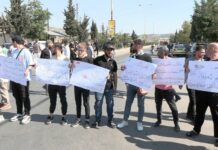
As Lebanese civilians flee the intensifying Israeli airstrikes on southern Lebanon, many are seeking refuge in neighboring Syria. However, reports indicate that the Assad regime is capitalizing on the crisis for economic gain and political maneuvering, imposing financial burdens on the displaced while facilitating special treatment for Hezbollah affiliates.
On the surface, the Syrian regime, through its Central Bank, has implemented measures to ease the entry of Lebanese and Syrian refugees fleeing the violence. The bank has deployed mobile offices and exchange services to border crossings to provide banking services, including cash withdrawals and foreign currency exchanges.
Yet, many observers believe these measures are a thinly veiled attempt at exploitation. Displaced people from both Lebanon and Syria face skyrocketing prices for basic goods and services at the Syrian border, where the Assad regime controls key economic transactions. The mandatory exchange of $100 USD before entering Syrian territory is a significant burden for many refugees, particularly poor families, who are already grappling with the high costs of transportation and accommodation.
The requirement for Syrians to exchange $100 USD, established by the regime in 2020, remains in place even for those fleeing the Israeli bombardment. The Assad regime maintains that this is a routine procedure, yet critics argue it is a blatant attempt to boost foreign currency reserves amid the ongoing economic crisis.
“The [Assad] government has turned the border crossings into a profitable enterprise,” said a member of the “Syrian opposition,” who asked to remain anonymous. “Families fleeing for their lives are being forced to contribute to the regime’s dwindling cash reserves.”
Amid the refugee influx, concerns have arisen about preferential treatment for families and members of Hezbollah, a key ally of the Assad regime. The regime has reportedly streamlined entry procedures for Hezbollah fighters and their families, sparking fears of a broader political agenda.
Muhammad Salim Al-Khatib, a member of the Political Bureau of the Syrian National Coalition (SNC), expressed his concern that the Assad regime is using the crisis to further an ongoing project of demographic change. “The regime and Iran have long sought to settle Hezbollah families in strategic areas of Syria to cement their influence,” Al-Khatib said. “This refugee crisis provides the perfect cover for them to do just that.”
The Assad regime, alongside Iran, has been accused for years of attempting to engineer demographic changes within Syria by resettling loyalist populations, particularly in predominately Sunni areas effectively erasing Sunni communities in the process. Many fear that the regime may use the current displacement of refugees as a pretext to resettle, mainly Shiite, Hezbollah families in key areas, complicating future efforts for Syrian refugees to return to their homes and further entrenching Iranian support and influence in the country.
Al-Khatib voiced his concerns that this would not only displace more Syrians but also undermine any potential political resolution to the conflict. “This amounts to creating a new reality on the ground, one that prevents the return of Syrian refugees and entrenches Iranian and Hezbollah influence in Syria,” he said.
Meanwhile, Syrians fleeing Lebanon face dual hardships: escaping bombardment and grappling with the regime’s excessive policies. Many fear returning to regime-controlled areas due to the risk of arrest and forced disappearance, a fate that has befallen hundreds of returnees over the past years.
For those already burdened by economic hardship and displacement, the mandatory $100 exchange, increased transportation costs, and inflated real estate prices add to their struggles. “It feels like we are more besieged than ever,” said one Syrian refugee who fled to the border. “We left Lebanon in fear of bombs, only to face a different kind of exploitation.”
As tensions escalate in the region and refugees pour into Syria, the Assad regime is using the opportunity to bolster finances and further political objectives. Through the exploitation of refugees and preferential treatment of Hezbollah affiliates, the regime appears to be solidifying its long-term strategy of demographic manipulation and war profiteering.








